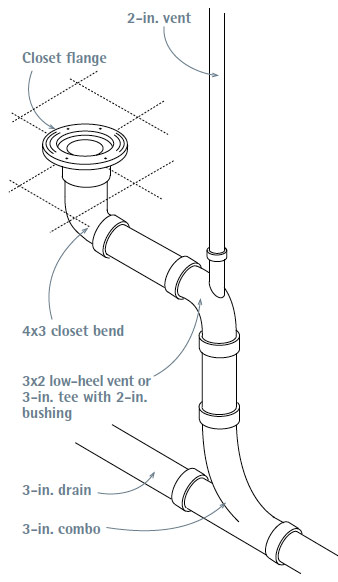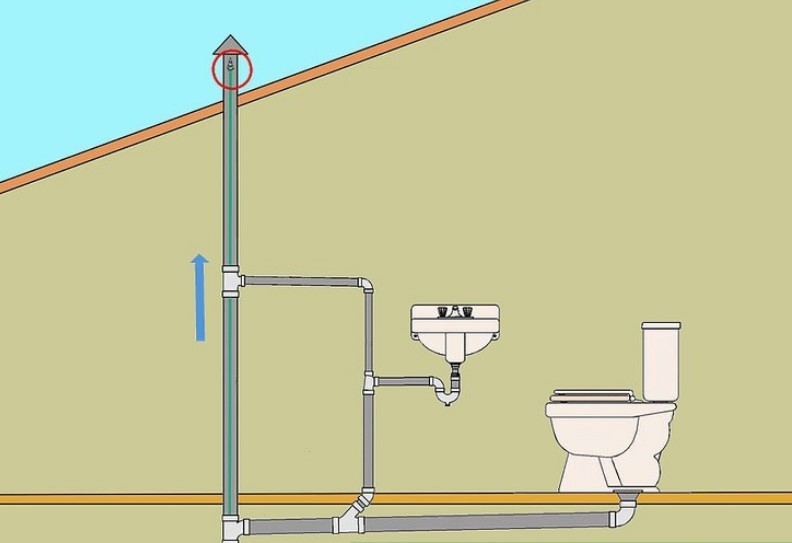The Importance of Correct Ventilation in Your Plumbing System
The Importance of Correct Ventilation in Your Plumbing System
Blog Article
This article which follows about The Upsides of Proper Ventilation in Plumbing Design is truly captivating. Read on and draw your own results.

Correct ventilation in pipes systems is usually ignored, yet it is critical for maintaining the capability and security of your home's plumbing. Air flow helps regulate atmospheric pressure, stop the buildup of damaging gases, and make certain the efficient removal of waste. In this guide, we will explore the value of correct pipes ventilation, how it functions, and the benefits it gives your pipes system.
Exactly How Air Flow Works in Pipes Systems
Atmospheric Pressure Policy
Correct air flow keeps well balanced atmospheric pressure within the plumbing system. When water flows via pipelines, it displaces air. Without appropriate ventilation, this variation can develop adverse pressure, causing slow down drains pipes or siphoning of water from traps, which can create undesirable odors to permeate into the home.
Protecting Against Sewage System Gas Accumulation
One of one of the most important functions of plumbing vents is to prevent sewer gases, such as methane and hydrogen sulfide, from gathering within the home. These gases can posture major health threats and are highly combustible. Vent pipelines enable these gases to escape safely outside.
Helping in Waste Removal
Ventilation assists in the effective elimination of wastewater by protecting against airlocks in the drainage system. When air can move easily through the vents, it permits water and waste to move efficiently with the pipelines, decreasing the danger of obstructions and back-ups.
Advantages of Proper Ventilation
Boosted System Performance
Effectively ventilated plumbing systems run a lot more effectively, with fewer clogs, faster draining pipes, and less pressure on the pipelines. This efficiency extends the life-span of the plumbing system.
Improved Air High Quality
By avoiding sewage system gases from entering your home, correct ventilation contributes to far better indoor air quality, making your living environment healthier and much more comfy.
Protecting Against Water Damage
Ample air flow assists prevent water from being siphoned out of catches, which can cause sewer gases entering the home and causing water damage in time.
Actions to Make Certain Appropriate Air Flow
Consulting Pipes Codes
Constantly consult local pipes codes when creating or changing your pipes system. These codes supply the essential standards for proper venting and ensure your system meets safety requirements.
Normal Evaluation and Upkeep
Normal evaluations can assist recognize potential air flow problems prior to they become major troubles. Maintenance jobs, such as cleaning air vent pipelines and looking for obstructions, are vital for maintaining the system in good working order.
Professional Setup
For brand-new installments or significant modifications, it's a good idea to hire an expert plumbing. They have the experience to guarantee the ventilation system is correctly made and mounted according to code.
Comprehending Air Flow in Pipes
Air flow in pipes refers to the network of pipelines that permit air to move through the water drainage system. These vents offer multiple functions, including controling atmospheric pressure within the pipes, protecting against sewer gases from entering the home, and assisting in the smooth circulation of wastewater.
Sorts Of Pipes Vents
Key Heap Vent
The primary pile vent, also known as the air vent pile, is the primary vent in a pipes system. It prolongs from the main drainpipe align through the roofing system, enabling gases to get away and fresh air to go into the system.
Branch Vent
Branch vents connect to the primary pile air vent and serve individual fixtures, such as sinks, bathrooms, and showers. These vents ensure that each component has adequate air flow to work properly.
Air Admittance Valve (AAV).
An Air Admittance Valve (AAV) is a one-way valve that allows air to enter the plumbing system without the need for a conventional vent pipe expanding via the roofing system. AAVs are typically utilized in improvements or areas where setting up a typical air vent is not practical.
Indications of Poor Air Flow in Plumbing.
Slow Draining Fixtures.
If your sinks, tubs, or toilets are draining gradually, it could be a sign of inadequate ventilation. Poor air flow can develop a vacuum cleaner effect, making it hard for water to drain properly.
Gurgling Seems.
Gurgling sounds originating from drains are usually an outcome of air being sucked through water catches as a result of adverse stress in the pipelines. This is a clear indicator of insufficient air flow.
Undesirable Odors.
Drain smells inside your home are a warning that your pipes system is not properly aerated. This can imply that sewage system gases are not being properly vented outside, bring about possibly hazardous conditions.
Common Ventilation Mistakes.
Insufficient Vent Sizing.
Utilizing undersized air vent pipes can cause bad air flow and pressure discrepancies in the system. It's essential to use vents that meet the specific needs of your pipes system.
Improper Vent Placement.
Placing vents too much from the fixtures they serve can reduce their efficiency. Correct placement makes sure that air can move easily and effectively through the system.
Ignoring Code Demands.
Building regulations offer specific standards for plumbing air flow. Neglecting these codes can lead to a system that fails to operate correctly and might result in pricey repair services or health hazards.
Final thought.
Correct ventilation is a critical element of any plumbing system, making certain that it functions efficiently and safely. By comprehending the value of ventilation, acknowledging the indications of bad ventilation, and taking steps to preserve your system, you can protect against costly issues and protect your home's air top quality.
4 Things You Should Know About Your Plumbing Vents
What Plumbing Vents Are
Also called a vent stack, a plumbing vent is a vertical pipe attached to your drain line that runs through your roof. The plumbing vent pipe, or plumbing air vent, removes gas and odors from your plumbing system and allows fresh air to enter the pipes, helping the water to flow out of the drain pipes.
What Plumbing Vents Do
Plumbing vents have two basic functions. One of which is to allow unpleasant smelling wastewater and sewer gasses to escape your plumbing system instead of entering your home. Plumbing vent pipes are typically located on roofs, away from windows, to ensure the fumes exit the home completely.
The other function of the plumbing vent is to move fresh air into your plumbing system. This helps move water through every plumbing fixture in your house, like toilets and sink drains. Think of the way in which you need to let a little air into the bottle as you pour soda in order to make the drink flow smoothly.
Different Types of Plumbing Vents
True vent: This is the most common vent option. In simplest terms, a true vent is a vertical pipe attached to your drain line that exits through the roof. They often function as the main vent that other fixtures can connect to. Re-vent pipe or auxiliary vent: Attached to the drain line near specific plumbing fixtures, re-vent pipes run up and over to connect to the main vent. Common vent: Two plumbing fixtures installed on opposite sides of a wall are typically tied into the vent stack using something known as a sanitary cross. Wet vent: This venting option operates as a drain pipe and a vent at the same time. Wet vent drainage systems drain water from one fixture while venting the air from another. Although they’ve been used for over 100 years, wet vent systems have only recently been added to the plumbing code in many areas. If you’re planning on installing one in a bathroom remodel, make sure you check your local code prior to construction. Loop vent: For free-standing fixtures like kitchen island sinks, loop vents are ideal. These vent pipes run under the floor, rise from the P-trap, and create a loop inside the cabinet sink. Air admittance valve: An AAV is a one-way mechanical valve typically installed at the site of the plumbing fixture. AAVs allow venting to occur without having to tie into a larger venting system. They’re ideal for venting fixtures where you aren’t able to easily connect to an existing vent system. Common Plumbing Vent Issues
Although vent pipes typically don’t have water flowing through them, they’re still subject to many typical plumbing issues. For example, clogs are one of the most common problems associated with sewer vent pipes. If your vent pipe gets clogged, all of your plumbing fixtures tied into the vent stack will be affected.
A sink with a slow drain that bubbles and gurgles or a strong sewage smell around your toilet are both indicators that your toilet vent pipe is clogged. Because most vent pipes exit through the roof, old leaves, twigs or even a bird’s nest could be clogging the pipe.
Clogs in your vent pipe system cause a buildup of negative pressure, meaning that water won’t be able to flow out of your home very well. It’s similar to putting your finger over the opening of a straw to trap water inside. When you remove your finger, the water is able to flow out of the straw.
If you suspect you have any blockage in your vent, make sure you have a professional come examine the situation. Left unchecked, a blocked air vent can lead to other costly repairs, like leaks and sediment buildup.
Under Pressure
Pipe vents are essential aspects of a home’s plumbing system. Owning a home means learning about all sorts of things you never put much thought into before. But by understanding as much as you can about the important systems of your home, you can keep those budgets intact and those anxiety levels low.
https://www.homeserve.com/en-us/blog/home-improvement/plumbing-vents/

Do you enjoy more info about What Are Plumbing Vents and Why Are They Important?? Write a review down below. We'd be happy to hear your opinion about this blog post. Hoping to see you back again before long. Remember to set aside a second to distribute this blog post if you liked it. I enjoy your readership.
About This Report this page